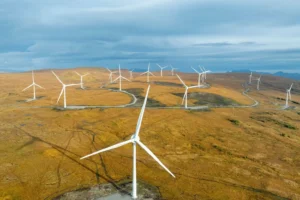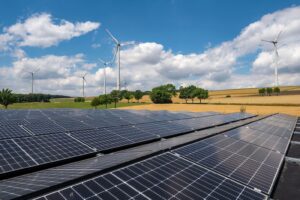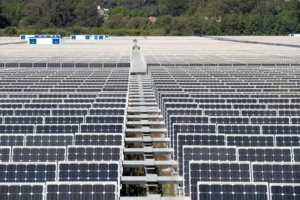Last week, hundreds of scientists, policymakers and journalists flocked to the University of Exeter to attend an international conference on “tipping points”.
The conference saw experts discussing the dangers of a range of Earth system tipping points, including the dieback of the Amazon, the melting of the Greenland ice sheet and the shutdown of the Atlantic Meridional Overturning Circulation (AMOC).
Attendees also explored “positive tipping points” – large-scale, self-propelling social changes that would reduce the impact of humans on the climate.
(For more on the key talking points, new research and ideas that emerged from the four-day event, see Carbon Brief’s full write-up of the event.)
On the sidelines of the conference, Carbon Brief asked a wide range of delegates which tipping point concerns them the most.
These are their responses, first as sample quotes, then, below, in full:
- Prof Gabi Hegerl: “I am particularly worried about tipping points that involve the biosphere and humans due to breaching thresholds for heat or drought that then ripple into food availability, livelihood and ecosystems.”
- Prof Carlos Nobre: “The Amazon is a very serious tipping point, because [dieback] could release around 250bn tonnes of CO2 by 2100 – which will make it impossible to [limit global warming] at 1.5C.”
- Gaia Vince: “I would say that we have already passed the tipping point for coral reef ecosystems…As a scuba diver, I find it a tragedy because I love coral reef ecosystems, but it’s also a tragedy for human systems.”
- Dr Andrew Hartley: “The tipping point I’m most concerned about is Amazon forest dieback…because of the significance of the carbon cycle and the feedback to the global climate. Also [due to] the effects that Amazon tipping has on food security, both locally and globally.”
- Prof Tim Lenton: “The Atlantic Meridional Overturning Circulation, or AMOC, for sure. The consequences of crashing that would be devastating globally – and also for where I live in the UK.”
- Prof Peter Cox: “The one that I’ve worked on most and worries me most at the moment is Amazon dieback. And that’s because we’ve got two things, two stressors, going on at once that push it in the wrong direction. Climate change is one, deforestation is another.”
- Prof Johan Rockström: “The tipping element that worries me most is coral reef systems, for the simple reason that the scientific uncertainty range is very limited.”
- Dr Patricia Pinho: “For me, it is the Amazon…I think it’s going to be a really profound, irreversible change that will affect the global population in the most dramatic way.”
- Prof Ricarda Winkelmann: “I’m mostly concerned about the Greenland and West Antarctic ice sheets. This is because we know that, even at lower warming levels, they are already at risk of transgressing tipping points in certain regions.”
- Dr Nico Wunderling: “The tipping element that worries me most is the Amazon rainforest. This is because the Amazon rainforest is not only threatened by climate change, but also by deforestation at the same time.”
- Dr Rebecca Shaw: “The coral reef tipping point…It signals the end of the most colourful and biodiverse ecosystem which supports the nutrition and livelihoods of over one billion people.”
- Dr David Obura: “The ice [tipping elements] – because they are the first ones to go that have cascading impacts on other tipping elements.”
- Dr David Armstrong McKay: “The Amazon is actually probably closer to a deforestation-induced tipping point than to a climate change-induced tipping point. So, I actually think that could be potentially in the offing sooner than we would like.”
- Kate Raworth: “The tipping point that I fear we will fail to cross is [the social tipping point] around transforming our mindsets.”
Chair in climate system science in the school of geosciences at the University of Edinburgh
I am worried about all of them, but for the immediate future, I am particularly worried about tipping points that involve the biosphere and humans due to breaching thresholds for heat or drought that then ripple into food availability, livelihood and ecosystems. The Earth system tipping points will do that too, but maybe a little bit later. Examples [of this] are the coral diebacks triggered by marine heatwaves, forest change and fires, and droughts threatening livelihoods and putting people on the move.
I did a research project on the US Dust Bowl and the trigger [for that event] was drought causing vegetation and crop dieback, [which led to] extreme heat and dust storms in response – and migration, as memorialised in [the 1939 John Steinbeck novel] The Grapes of Wrath. And, now with warming, all droughts get supercharged.
Prof Carlos Nobre
Scientist and meteorologist who spearheaded the multi-disciplinary, multinational large-scale biosphere-atmosphere experiment in Amazonia
The Amazon is a very serious tipping point, because [dieback] could release around 250bn tonnes of CO2 by 2100 – which will make it impossible to [limit global warming] at 1.5C. We could also lose the largest [host to] biodiversity on the planet, which would induce a tremendous, large number of epidemics and several pandemics. Also, of course, the Amazon forest controls aspects of the global climate. In South America, the climate is entirely controlled by the Amazon forest.
I’m most worried about Amazon [dieback] because I have worked on it for 40 years. But the other tipping points deeply concern me. The melting of the permafrost will release more than 200bn tonnes [of greenhouse gases], mostly methane. Ice sheet melt in Greenland is a very serious tipping point because it could raise sea level rise by three metres in 200 years. The melting of Greenland has already started. Species extinction is also very serious.
One thing that was not much talked about [at this conference] is that when the ocean heats up, particularly the Arctic Ocean, then a tremendous amount of methane is released. And if that happens – if the Arctic Ocean warms up by 3-4C – the amount of methane that would be released could see [air] temperatures reach 8-10C [above pre-industrial levels]. At 8-10C, the only inhabitable places for us humans will be the top of the Alps, the Andes and the north and south poles. The rest of the planet would be uninhabitable.
 Gaia Vince
Gaia Vince
Science writer and broadcaster
I would say that we have already passed the tipping point for coral reef ecosystems, for example. That really is a tragedy. As a scuba diver, I find it a tragedy because I love coral reef ecosystems, but it’s also a tragedy for human systems. They are the nursery for our fisheries. And, of course, they’re not just fisheries – they are a valid ecosystem and a biodiversity hotspot. This will have untold consequences and cascading impacts for other parts of the ecosystem, for example, the cycling of nutrients and coral reefs are really important to stop coastal erosion. And they actually provide sand, the lovely white sand that people go on holiday for Bucha.
 Dr Andrew Hartley
Dr Andrew Hartley
Climate impacts scientist at the Met Office Hadley Centre
The tipping point I’m most concerned about is Amazon forest dieback and reduction in the function of the Amazon forest, because of the significance of the carbon cycle and the feedback to the global climate. Also [due to] the effects that Amazon tipping has on food security, both locally and globally, because of [the Amazon’s] contribution to major commodity markets, such as soybean and maize.
This might interact with climate change in the future to lead to more severe events, particularly in populated areas of Brazil. If an Amazon tipping point were to occur, it might lead to more severe events on the coast of Brazil which would affect a much larger population. There are negative impacts across the forest from the drying of the forest, for example for the Indigenous communities, but also globally.
 Prof Tim Lenton
Prof Tim Lenton
Founding director of the Global Systems Institute and chair in climate change and Earth system science at the University of Exeter
The Atlantic Meridional Overtoning Circulation, or AMOC, for sure. The consequences of crashing that would be devastating globally – and also for where I live in the UK. By our own calculation, we could have less than half the viable area for growing a couple of major staple crops, wheat and maize worldwide. We would have a widespread water crisis. We could have collapses of the monsoons in West Africa and India that would displace hundreds of millions of people. It is hard to see that as anything other than a catastrophe.
 Prof Peter Cox
Prof Peter Cox
Professor of climate system dynamics in mathematics and director of the Global Systems Institute at the University of Exeter
The one that I have worked on most and worries me most at the moment is Amazon dieback. And that’s because we’ve got two things, two stressors going on at once that push it in the wrong direction. Climate change is one, deforestation is another. You can imagine crossing the boundary in various ways – but, if you push diagonally, you get there quicker.
If I had spoken to you 25 years ago, I would have said I’m really worried about [Amazon dieback]. Then I went through a phase of thinking that the models have overdone it. And now I’m thinking the models that don’t include land-use change are underdoing it. So, I’m more concerned about that one.
There are others as well, but that is the one that is also quite fast. The other [tipping points] we worry about, we’re worried about a long-term commitment. It takes a while for the AMOC to shut down, it really does. It takes a while for the Greenland ice sheet to melt. We’ve done work that suggests you can overshoot even a little bit for these slow systems. The Amazon forest is a decadal dieback, especially if it is fire driven.
 Prof Johan Rockström
Prof Johan Rockström
Director of the Potsdam Institute for Climate Impact Research (PIK) and professor in Earth system science at the University of Potsdam
There is not a simple answer to this – there is a two-part answer.
The tipping element that worries me most is coral reef systems, for the simple reason that the scientific uncertainty range is very limited. We have, unfortunately, ample evidence that at 1.5C we’re very likely to knock over, potentially, the entire tropical coral reef system on Earth. [This threatens] the livelihoods of 400 million people and a fundamental nursing ground for the whole ocean food web. So that is one deep concern. It is the canary in the coal mine – the first kid on the block to fall over. We’re so close.
The second one is AMOC – the whole overturning of heat in the Atlantic, which connects the entire ocean system. Not only is the latest science showing that we are going from low likelihood to uncomfortably high likelihood, but we also know – with very little uncertainty – that this would cause a catastrophic impact across the entire world, and it would go fast. So the AMOC, I would argue, is today the most important scientific message to the world. If you want a really hard-hitting reason to act at a level of planetary emergency, it is the AMOC. That is the second one.
From a planetary boundary perspective, it is important to recognise that – on climate science grounds – the Amazon basin is not at risk of tipping until 3-5C of warming. But as soon as you factor in loss of biodiversity, deforestation and changes in hydrology – then the temperature risk goes down to between 1.5-2C. So suddenly – when taking a more integrated [assessment] approach – the conclusion is that it is also very close to a tipping point.
 Dr Patricia Pinho
Dr Patricia Pinho
Deputy science director at the Amazon Environmental Research Institute (IPAM)
For me, it is the Amazon. When we think of the planetary crisis, we think about the Amazon and all the regulating climate services it provides. This is not only regionally, but we know it’s a global “climate good”, if you will. But it is highly sensitive to land-use change and increasing temperature. So, if we transition to a point of no return – Amazon dieback – and transforming or transitioning to another ecosystem, the function of the forest will not be doing what it has been doing for the past millennium and so on. And then we cannot revert this loss. I think it is going to be a really profound, irreversible change that will affect the global population in the most dramatic way.
Of course, we have the people on the front line that I’m working with – Indigenous people, traditional population – that are safeguarding this resource, but they are also at the front line of climate risks and the impacts that we already observe. If we miss this opportunity of really reverting from increasing greenhouse emissions and increasing temperature, we’re going to miss the window of opportunity to really protect the region, protect the ecosystem and the forest for the global society.
 Prof Ricarda Winkelmann
Prof Ricarda Winkelmann
Founding director of the Max Planck Institute of Geoanthropology and professor of climate system analysis at PIK and the University of Potsdam
So I am thinking about this from a risk perspective – so both the likelihood as well as the impacts – and I think the answer depends on that. Because when it comes to the likelihood and the particular threshold – and we know about those – I’m mostly concerned about the Greenland and the West Antarctic ice sheets. This is because we know that, even at lower warming levels, they’re already at risk of transgressing tipping points in certain regions.
But when it comes to the impacts and also the timescales over which those play out, there are other tipping elements that worry me most. In particular, regional tipping elements. So if we think of the mountain glaciers, for instance, these impacts are already experienced right now and several mountain glaciers are undergoing these accelerated changes. And so thinking about the timescales when it comes to the impacts is also incredibly important.
 Dr Nico Wunderling
Dr Nico Wunderling
Junior professor at the Center for Critical Computational Studies at Goethe University Frankfurt and researcher at the Potsdam Institute for Climate Impact Research.
The tipping element that worries me most is the Amazon rainforest. This is because the Amazon rainforest is not only threatened by climate change, but also by deforestation at the same time. So that means that the critical threshold from climate change alone, at around 3-4C of global warming, can come down to 1.5-2C. Climate change and deforestation basically go hand-in-hand to lower the [Amazon’s tipping] threshold because of this double threat.
 Dr Rebecca Shaw
Dr Rebecca Shaw
Chief scientist and senior vice-president at WWF
The coral reef tipping point – it comes first because of warming surface waters, and then the outcome is sealed by ocean acidification. It signals the end of the most colourful and biodiverse ecosystem which supports the nutrition and livelihoods of over one billion people and has captured the imagination of more people than any other through the characters like Nemo the clownfish, SpongeBob SquarePants, and, of course, Frank the coral [a character from an educational YouTube video].
If humanity is not motivated to act in the face of the loss of coral reefs, is there hope that we will act in time to prevent the Amazon and glacier tipping points?
 Dr David Obura
Dr David Obura
Chair of the Intergovernmental Science-Policy Platform on Biodiversity and Ecosystem Services and founding director of CORDIO East Africa
The ice [tipping elements] – because they are the first ones to go that have cascading impacts on other tipping elements. When [ice masses] reduce, we lose their albedo, waters heat up more [and] the AMOC can collapse. That has the biggest impact across the planetary system, including the Amazon.
My own [research], of course, is coral reefs. So, in a way, the coral reef tipping point does concern me the most. [But] it doesn’t have cascading impacts on other tipping elements. It does on people, in socioeconomic terms – but not on other system elements. So, in a sense, it is the least worrying one.
 Dr David Armstrong McKay
Dr David Armstrong McKay
Lecturer in geography, climate change and society in the school of global studies at the University of Sussex and lead author on an influential tipping points assessment, published in Science in 2022
One of the tipping systems that concerns me the most is Amazon rainforest dieback. Because even though we assessed it a few years ago as having a warming threshold that’s a bit higher than what we might be seeing – we’ve thought it is maybe at a best estimate of 3.5C – there’s also deforestation as well. The Amazon is actually probably closer to a deforestation-induced tipping point than to a climate change-induced tipping point. So I actually think that could be potentially in the offing sooner than we would like. That would have huge impacts for biodiversity, for South America as a whole, by shifting rainfall patterns, which would really affect a lot of people for agriculture or ecosystems. Also, the Amazon as an ecosystem is so incredibly biodiverse and amazing in itself, it would be a tragedy to lose it.
 Kate Raworth
Kate Raworth
Senior visiting research associate and lecturer at the University of Oxford’s Environmental Change Institute and co-founder and conceptual lead of Doughnut Economics Action Lab
The tipping point that I fear we will fail to cross is [the social tipping point] around transforming our mindsets. We need to move from the extractive, degenerative economy towards a regenerative one. This all starts within our head and it underlies everything.
[A failure to do this] is what is driving us towards all these [Earth system tipping points].
The post Experts: Which climate tipping point is the most concerning? appeared first on Carbon Brief.
Experts: Which climate tipping point is the most concerning?
Greenhouse Gases
DeBriefed 1 August 2025: Trump targets ‘endangerment finding’; Floods and heatwaves; ‘Thirst’ exhibition
Welcome to Carbon Brief’s DeBriefed.
An essential guide to the week’s key developments relating to climate change.
This week
Trump to overturn ‘endangerment finding’
EPA OVERTURNING: The Trump administration announced its plan to overturn the 2009 finding that has been the “central basis” for US action to regulate greenhouse gas emissions, the Associated Press reported. A new Environmental Protection Agency proposal would rescind the “endangerment finding”, which determined that carbon dioxide and other greenhouse gases endanger public health and welfare, according to the newswire. If the finding is repealed, it would “erase current limits” on greenhouse gas pollution from cars, factories and power plants, AP said.
‘MISLEADING’ REPORT: The proposal is supported by a new Department of Energy report that uses “misleading and inaccurate” statements to argue that climate science has “overstated” the risks of a warming planet, Politico reported. The report, which also argues that climate science is “underestimating” the societal benefits of burning fossil fuels, was written by five scientists who “are known” for “denying accepted climate science”, the outlet added.
‘WINDMILL DISGRACE’: Wind development on federal lands and waters may be halted by the Trump administration, Bloomberg reported. Interior secretary Doug Burgum ordered a comprehensive review of the agency’s approval process, it said. According to Renewable Energy News, the department said more than 3.5m acres offshore were designated as “wind energy areas” by the last administration and that “terminating” these areas is “safeguarding” local environments and economies from “unchecked development”. This followed from Trump’s recent comment that “windmills are a disgrace”, the publication added.
Floods and heatwaves
SEVERE FLOODING: Torrential rains triggered a devastating flood in northern Nigeria, leaving at least 23 people dead, Deutsche Welle reported. The flooding has displaced 5,560 people and left dozens injured, according to the National Emergency Management Agency. More than 200 people have been killed in floods in Nigeria since the start of the rainy season in May this year, according to DW. The outlet reported that scientists have said climate change is fuelling many of these extreme weather occurrences.
BEIJING RAINS: China faced “another deadly rainy season” after 60 people were killed following days of torrential rain in Northern Beijing, reported Reuters. The outlet said climate change has made extreme weather “more frequent and intense”. Elsewhere, floodwaters from the Indus and Chenab rivers have “inundated” more than a dozen villages across Pakistan’s Punjab province, said India’s Tribune.
RECORD TEMPERATURE: Japan recorded its hottest day on record as temperatures reached 41.2C in southwest Tokyo, Al Jazeera reported. There were 16 heat-related deaths and more than 10,800 people were hospitalised with heatstroke last week, the outlet said. Meanwhile, the Iraqi government issued an official holiday in seven of its provinces as temperatures topped 50C, said Gulf News.
‘MILLIONS’ INSIDE: Temperatures soaring in the US have led to “millions” of Americans being warned to stay inside as some areas reach 48.8C, noted Newsweek. Heat warnings and advisories have been issued by the National Weather Service, according to the outlet.
Around the world
- ENERGY PLEDGE: The European Union has pledged to buy $750bn of energy from the US in exchange for a lower tariff rate under its trade deal with Trump. “Significant purchases” of US oil, liquified natural gas and nuclear fuel to replace Russian fossil fuels are included in the deal, CNBC reported. The Financial Times quoted energy experts saying the deal is a “pie in the sky” given that “US fossil fuel supplies [in 2024] to the bloc accounted for just $75bn”.
- COP30 COSTS: The UN held an “urgent meeting” over “sky-high” accommodation costs ahead of the COP30 climate summit in Brazil, Reuters reported. Meanwhile, the last US climate negotiators have been fired by the Trump administration, leaving the nation with “no official presence” at the summit, said CNN.
- ‘MELTING RAPIDLY’: Glaciers in Turkey’s southeast are melting rapidly due to rising global temperatures “amid human-caused climate change”, Al Jazeera reported.
- ‘SEWAGE CRISIS’: The US and Mexico have signed a deal to end the Tijuana “sewage crisis”, committing to update outdated wastewater infrastructure to handle higher flows triggered by worse flooding, said Inside Climate News.
- RENEWABLE ENERGY: Australia’s government has pledged to “substantially increase” its renewable energy underwriting scheme following concerns the nation will struggle to meet its 2030 power target, noted the Guardian. Meanwhile, New Zealand’s government has voted to resume gas and oil drilling despite an “outcry” from the opposition and environmental groups, reported the New Zealand Herald.
- ‘UNHELPFUL TUSSEL’: UN climate chief Simon Stiell paid a visit to Australia and urged the nation and Turkey to resolve their “long-running tussle” over who will host the COP31 summit, calling the delay “unhelpful and unnecessary”, Reuters reported.
66.8 million
The hectares of intact tropical forest that overlaps with oil blocks in the Democratic Republic of Congo, according to Earth Insight.
Latest climate research
- Climate change could make ‘droughts’ for wind power 15% longer | Carbon Brief
- A study of urban construction workers in Taiwan found that heat stress imposes “substantial economic burden” and results in productivity losses in the range of 29-41% | Nature Cities
- Drought will increasingly contribute to the collapse of many bird species that live in highly arid regions of the US | Biological Conservation
(For more, see Carbon Brief’s in-depth daily summaries of the top climate news stories on Monday, Tuesday, Wednesday, Thursday and Friday.)
Captured
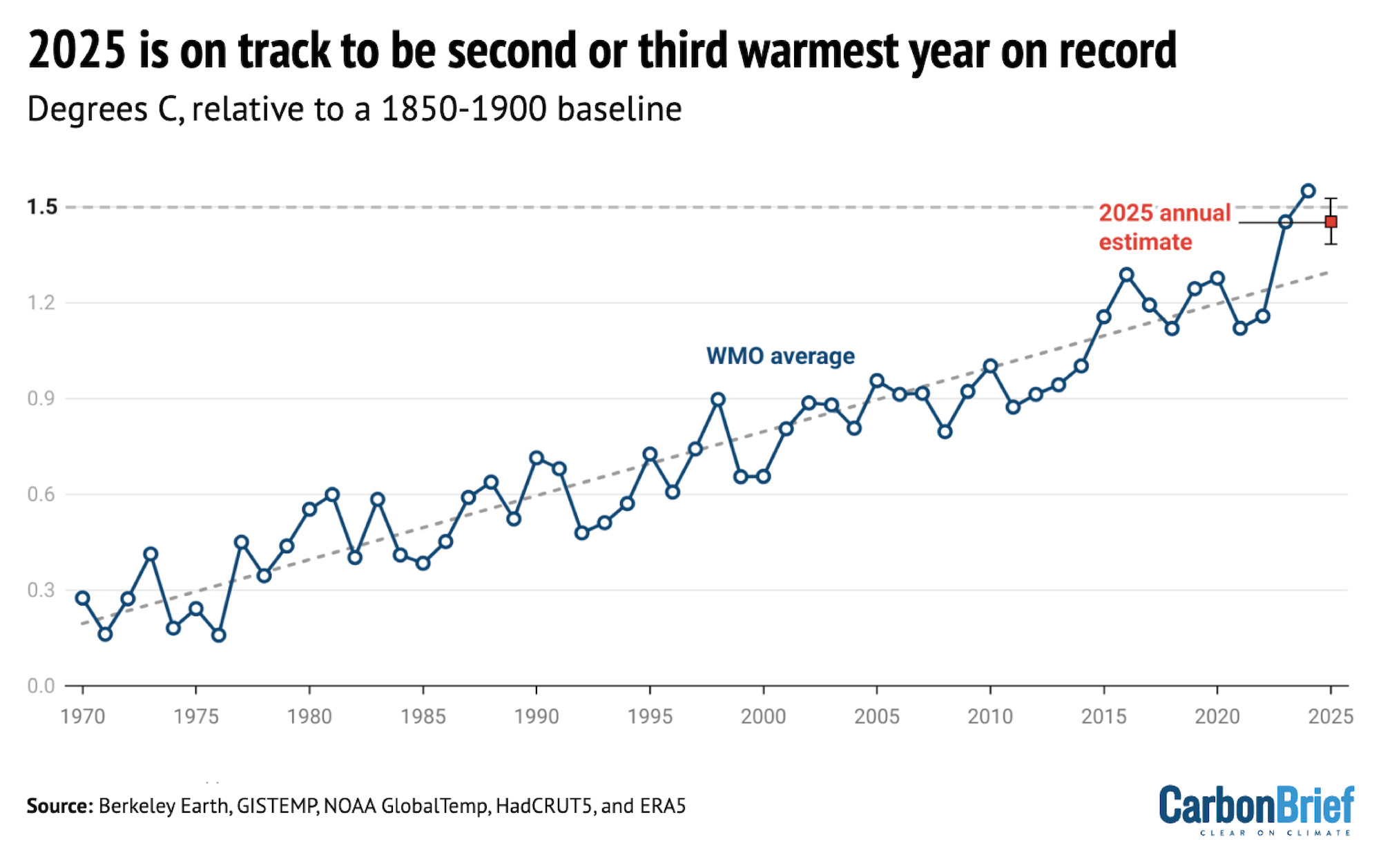
New analysis by Carbon Brief this week revealed that 2025 is on track to be the second or third hottest year on record. The chart above draws on data from five different research groups that report global surface temperature records to illustrate how 2025 saw the second-hottest first half of the year on record.
Spotlight
‘Thirst’ exhibition maps the water crisis
This week, Carbon Brief visits a London exhibition exploring the world’s worsening water crisis.
Intricate ink drawings on cotton paper explore interconnected issues in Nepal.
Global warming has melted glaciers in the region, causing flooding and infectious diseases, displacing human and non-human life.
Yet, through his drawings, Nepalese artist Karan Shrestha has created a mosaic of the Himalayan region that shows water as a signifier of extreme weather and a life-giving source to be shared.

His piece, “Water-giver, memory-keeper and the shifting forces”, is displayed at the Wellcome Collection for its “Thirst: In Search of Freshwater” exhibition.
Brought together by Wellcome curator and lecturer Janice Li, it features 125 objects that showcase the impact of climate change on water and its role in shaping health and ecosystems.
Li’s research into the etymology of “thirst” unravelled a global interpretation of water, reflecting the exhibition’s geographical breadth. She told Carbon Brief:
“Humans have faced really brutal and critical environmental crises and have, through a really deep innate knowledge of their own specific land, been able to devise monumental infrastructure to combat the crises they face.”
Just before Shrestha’s art in the exhibition are photographs taken by M’hammed Kilito.
In one picture, Kilito’s guide, Mustapha, looks into a dried-up well in a Moroccan oasis.
Climate change and human activities have resulted in the loss of two-thirds of oases in the country, according to information displayed at the exhibition.
Speaking about the photograph, Kilito told the Guardian that it looked like Mustapha was “praying for the return of something essential: water”.
Water adopts multiple faces in the exhibition: a vital yet scarce resource in certain pieces, a spiritual entity in others – and a destructive force.
Nothing makes the latter as clear as “Deluge” by photojournalist Gideon Mendel. Five screens display footage of the aftermath of severe floods around the world, captured by Mendel over 17 years.

Li told Carbon Brief:
“[Gideon] told me that, in the last two years, there’s always been a flood of that magnitude happening somewhere. He didn’t imagine that one day it would get to a point where he would have to choose which one to go to.”
Next to “Deluge” is a dome-like space where visitors can sit on bean bags and listen to glaciers melting in the Himalayas.
Though the exhibition confronts global water challenges, Li hopes it also reminds visitors of the resource’s beauty:
“Quite a few people told me they sit in the listening room for half an hour, really enjoying themselves and then guilt hits them because they’ve forgotten they’re listening to melting ice. But, this is the beauty of art, and a lot of beauty has come out of decay, destruction and deterioration because it also, sometimes, signals rebirth.”
Watch, read, listen
YAK HERDERS STRUGGLE: The Associated Press featured the stories of yak herders in India’s Himalayan mountains as climate change threatens their way of life.
PILOT ANXIETY: A Guardian documentary followed two airline pilots grappling with the climate impacts of their jobs.
‘IS DECARBONISATION DEAD?’: New York Times columnist Ezra Klein invited climate experts onto his podcast to discuss the future of renewable energy in the US.
Coming up
- 5-14 August: Second part of the fifth session of the Intergovernmental Negotiating Committee to Develop an International Legally Binding Instrument on Plastic Pollution, Geneva, Switzerland
- 9 August: UN international day of the world’s Indigenous peoples
- 11-15 August:UN Environment Programme’s International Methane Earth Observatory at AmeriGeo Week 2015: Earth Observations for the Americas, Bogotá, Colombia
Pick of the jobs
- Climate Justice Standard Lab, research associate in forest carbon and climate justice | Salary: $25-35 an hour. Location: Remote
- The Church of England, net-zero carbon programme decarbonising churches lead | £59,248. Location: Remote
- UN Office for Project Services, country engagement specialist and regional coordinator for eastern europe, Santiago network | Salary: Unknown. Location: Geneva, Switzerland
DeBriefed is edited by Daisy Dunne. Please send any tips or feedback to debriefed@carbonbrief.org.
This is an online version of Carbon Brief’s weekly DeBriefed email newsletter. Subscribe for free here.
The post DeBriefed 1 August 2025: Trump targets ‘endangerment finding’; Floods and heatwaves; ‘Thirst’ exhibition appeared first on Carbon Brief.
Greenhouse Gases
IEA: Renewables will be world’s top power source ‘by 2026’
Renewable energy will overtake coal to become the world’s top source of electricity “by 2026 at the latest”, according to new forecasts from the International Energy Agency (IEA).
The rise of renewables is being driven by extremely rapid growth in wind and solar output, which topped 4,000 terawatt hours (TWh) in 2024 and will pass 6,000TWh by 2026.
Wind and solar are increasingly under attack from populist politicians on the right, such as US president Donald Trump and Reform in the UK.
Nevertheless, they will together meet more than 90% of the increase in global electricity demand out to 2026, the IEA says, while modest growth for hydro power will add to renewables’ rise.
With nuclear and gas also reaching record highs by 2026, coal-fired generation is set to decline – driven by falls in China and the EU – meaning that power-sector emissions will decline, too.
The chart below illustrates these profound shifts in the global electricity mix – in particular, the meteoric rise of renewables, driven by wind and solar.
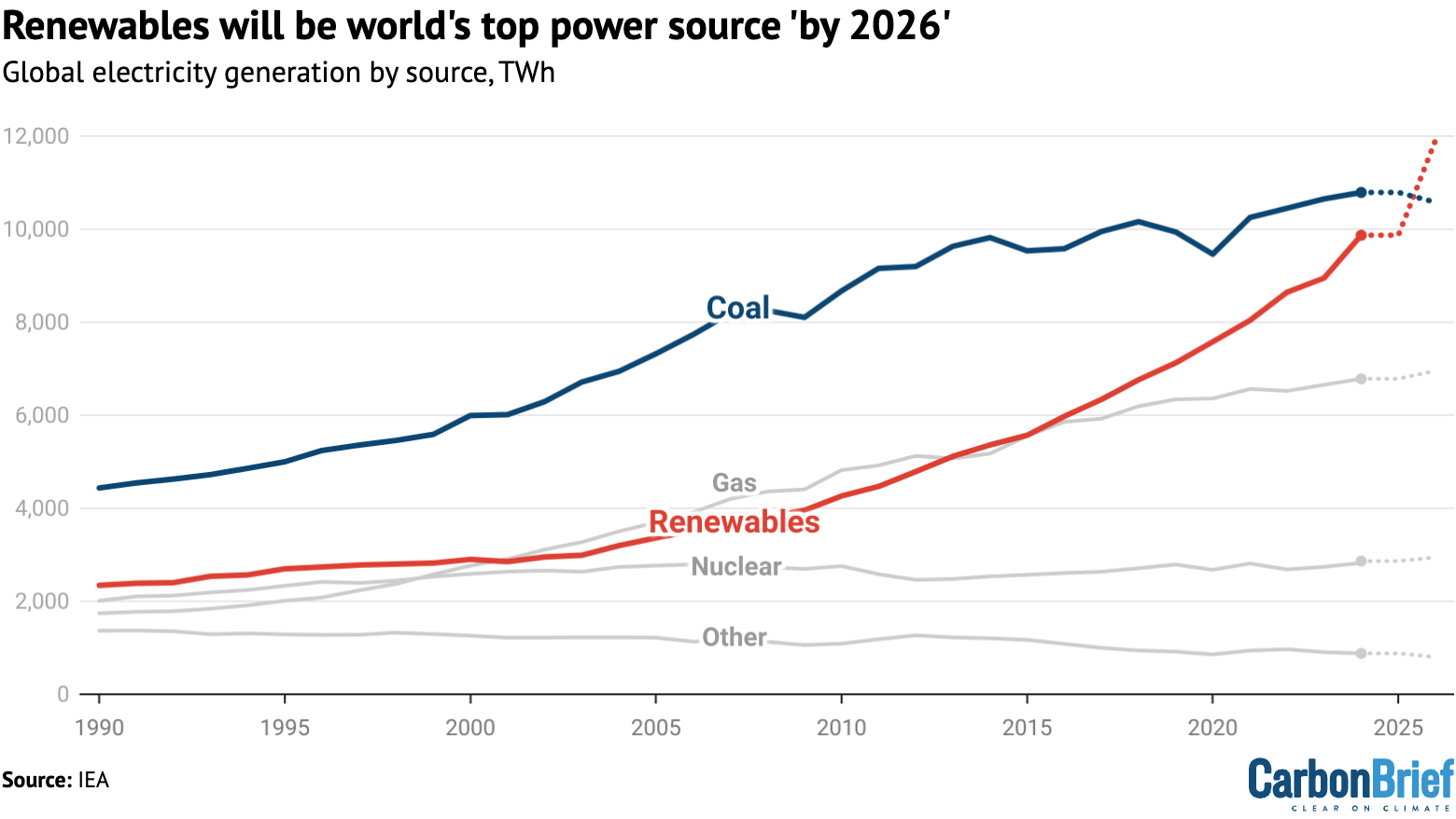
The IEA says that renewables could overtake coal as early as this year, depending on weather-related impacts on the output of wind and hydro capacity.
It adds that the switch will happen by 2026 “at the latest”, when renewables are expected to make up 36% of global power supplies, against just 32% from coal – the fuel’s lowest share in a century.
The share of global electricity generation coming from wind and solar combined will rise from 1% in 2005 and 4% in 2015 to 15% in 2024, 17% in 2025 and nearly 20% in 2026.
The global reduction in coal-fired electricity generation will result from declines in China and the EU, which will only be partially offset by increases in the US, India and other Asian nations.
The IEA attributes the coming decline of coal to “continued renewables growth and higher coal-to-gas switching in multiple regions”. It says gas power will rise by 1.3% this year and next.
For nuclear, the IEA says that the new record output will result from plant restarts in Japan, “robust” output in France and the US, as well as new reactors in China, India and South Korea.
The shift to wind and solar is happening despite global electricity demand being forecast to grow much faster over the next two years – at 3.3% and 3.7%, respectively – than the 2.6% average for 2015-2023.
The IEA says new demand is coming from industry, domestic appliances, growing use of air conditioning, ongoing electrification of heat and transport, as well as the expansion of data centres.
The post IEA: Renewables will be world’s top power source ‘by 2026’ appeared first on Carbon Brief.
Greenhouse Gases
Endangered angelshark faces ‘inhospitable’ breeding sites as ocean warms
“Unprecedented” ocean warming could make key habitats “inhospitable” for critically endangered angelsharks, according to new research.
The study, published in Global Change Biology, finds an “abnormal absence” of female sharks in a marine reserve near the Canary Islands throughout the 2022 breeding season.
This occurred during “unusually high” sea surface temperatures across the north-east Atlantic Ocean.
The study notes that the number of days with sea surface temperatures above 22.5C in the reserve nearly tripled over 2018-23.
This is significant, the authors say, because 22.5C is a “possible upper thermal threshold” for female angelsharks to tolerate.
The authors warn that ocean warming has “already altered” angelshark breeding behaviour, adding that the findings show that the species is “more acutely vulnerable” to climate change than previously thought.
Ocean warming
Angelsharks are flat-bodied, ray-like predators that can grow up to 2.4 metres in length.
They are typically found submerged in sandy habitats in the coastal waters of the north-east Atlantic Ocean and Mediterranean Sea.
They are listed as critically endangered on the International Union for Conservation of Nature’s (IUCN) red list of threatened species.
The authors note that the angelshark population has “declined substantially” due to “overexploitation” and “coastal habitat degradation”.
In the study, the researchers focus on the La Gaciosa Marine Reserve in the Canary Islands – Spain’s largest marine reserve.
The study notes that the Canary Islands are an “especially important region” for the angelshark and are at the “southernmost” boundary of the species’ distribution. As a result, angelshark populations around the islands have a “possibly lower tolerance for environmental change”, it states.
The researchers add that the north-east Atlantic Ocean is “undergoing rapid warming, characterised by exceptionally high temperatures and record-breaking marine heatwaves”.
As the climate continues to warm, extreme conditions are expected to occur more frequently and for longer, causing disruption to marine life.
The map below shows the historic and existing range of angelshark populations, as well as the locations of the acoustic receivers used to detect angelsharks in the study area.
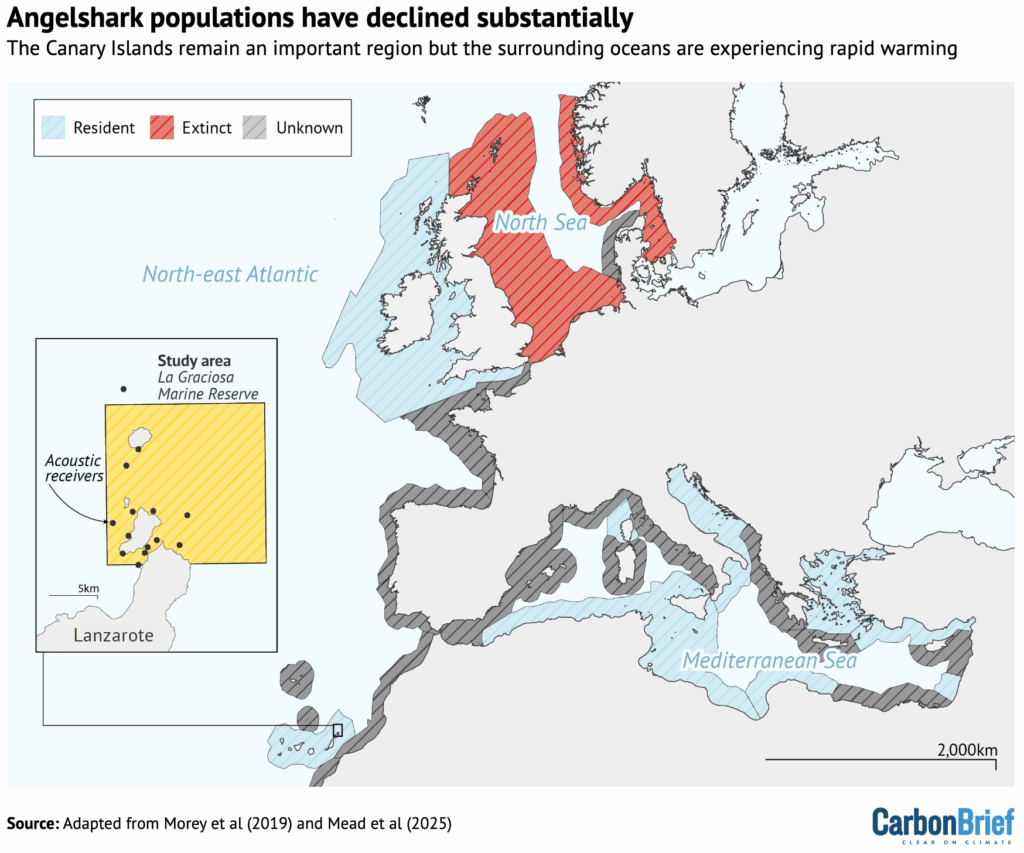
To explore how climate change in the region is impacting the angelsharks, the researchers focus on “range shift”.
Range shift is when a species migrates to either remain in ideal conditions or avoid sub-optimal environments, according to what they can withstand as the climate changes.
It is one of the most “pervasive” consequences of ocean warming, the study authors say.
Tracking angelsharks
To track the movements of angelsharks, the researchers tagged the fins of 112 animals – 38 males and 74 females – over 2018-22.
These “acoustic tags” emit sound that enabled the researchers to remotely track angelshark locations.
The researchers then used this acoustic data to investigate seasonal and annual changes to angelshark presence at the study site, taking into account the contrast between male and female behaviours.
The researchers also modelled changes to the environment over 2021-23 using a range of variables. These included sea surface temperature (SST), salinity, surface wind speed and SST anomaly – a measure of how temperatures differ from the long-term average.
They also looked at concentrations of chlorophyll a and dissolved oxygen, as well as two variables that act as an indicator for levels of desert dust in the air.
The latter were used to incorporate into their model the effect of Calima events – hot and dusty winds that reach the Canary Islands from the Sahara Desert, which raise overall air temperatures.
This “environmental model” allowed the authors to investigate the relationship between angelshark presence within the reserve and changing environmental conditions.
‘Marked absence’
Previous research has linked seasonal angelshark behaviours – such as movement and presence in a certain habitat – to the breeding cycle and, sometimes, environmental factors.
The new study finds that angelshark presence in the study area varies seasonally for both sexes, peaking in November and December. It notes an additional peak in June for female angelsharks, which were also more “consistently present” in the study area throughout the year than males.
Author Dr David Jacoby is a lecturer in zoology at Lancaster University. He explains to Carbon Brief:
“Females will often avoid males outside of the breeding season as mating is pretty violent and energy expensive in sharks. Females consequently are more likely to occur in shallow water [since] males [are more likely to be found] in deeper water.”
The charts below show the relative influence of different environmental variables on predicting male and female shark presence in the study area.
The chart on the left shows how the day of the year has the biggest influence on male angelshark presence, followed by salinity. The chart on the right shows that for female angelsharks, SST – followed by SST anomaly – was the most significant predictor.
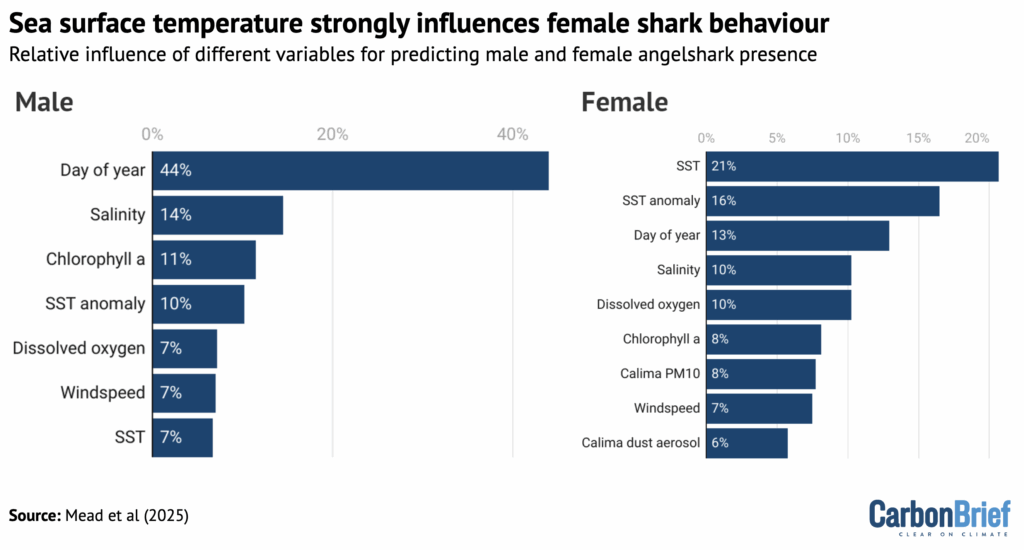
The “crux” of the study, according to Jacoby, is that in 2022 – when peak SSTs were higher and those conditions lasted longer – female angelshark numbers were “consistently low”. He tells Carbon Brief:
“The fact that there was this significant warming event in the north-east Atlantic was opportunistic from a research perspective at least, because it provided a natural experiment in which to directly compare behaviour under ‘normal’ versus ‘extreme’ conditions.”
This “marked absence” was especially noticeable during the angelshark breeding season in mid-to-late autumn, the data shows. In contrast, the behaviour of the male sharks did not change.
The charts below illustrate how, in 2022, daily counts of female angelsharks (orange bars in the middle panel) dropped in the unusually warm conditions, while daily counts of male angelsharks (turquoise bars in the bottom panel) remained consistent with previous years.
In the top panel, orange regions indicate periods in which SSTs are between 20.7C and 22.5C and red regions show periods of SSTs above 22.5C.
According to the authors, the presence of female sharks in the study site decreases “rapidly” at SSTs above 20.7C, while the “probability of female presence” is below zero above around 22.5C.
The dotted line at 19.6C shows the temperature of peak female angelshark presence.
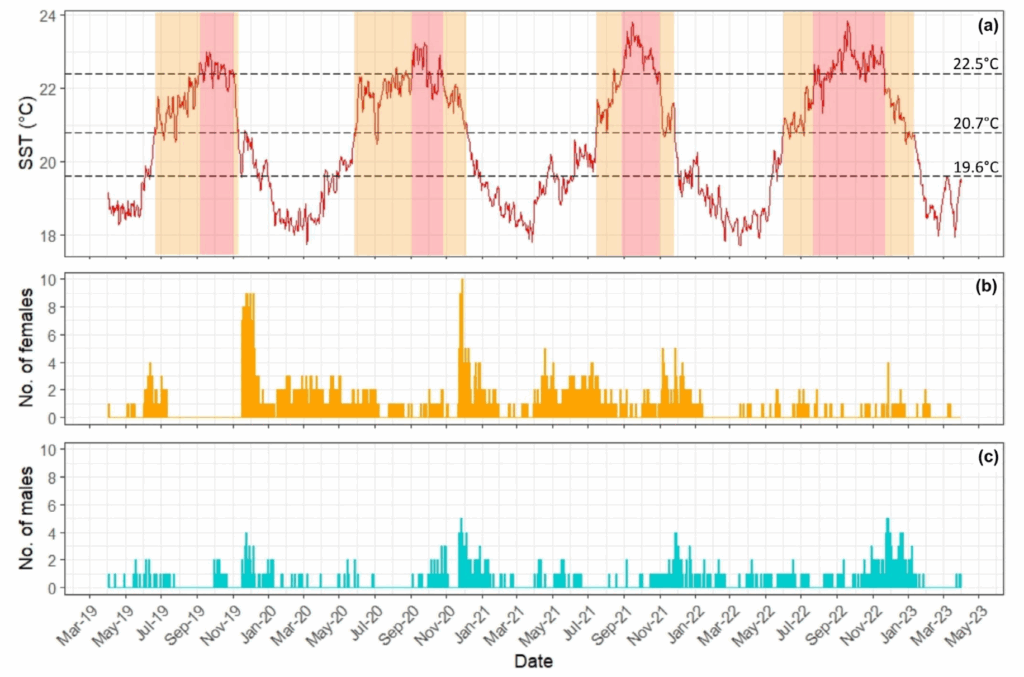
The researchers say their findings “strongly” indicate that the low numbers of females during the breeding season in 2022 were linked to the “thermal extremes” that year.
They point to an “upward trend” in peak temperatures and longer duration of hotter periods in their dataset, noting that the number of days where SSTs reached 22.5C more than doubled over the study period.
As a result, the authors identify 22.5C as the “possible upper thermal threshold” for female angelsharks – meaning that the animals will not move into an area at this point.
They warn that regular temperatures of 22.5C could “disrupt” the timing of “key biological events”, such as breeding.
The “unusual” findings, recorded as “disrupted” thermal cues, may be a “window into future climate change impacts”, suggest the authors.
Conservation measures
The authors highlight the need to prioritise further “species-specific” studies that incorporate “real-time environmental and behavioural data” and explore climate impacts by sex.
Improving scientific understanding and prediction of how marine species and ecosystems respond to climate change are “urgent priorities”, they say.
Jacoby adds:
“Angelsharks [are among] the most threatened fishes in the world. Because they rely on the ocean floor to rest and hunt, they are extremely attuned to their local environment. [Ocean warming] could lead to the [local extinction] of this species from the archipelago in a very worst case due to the fact that they are already at their thermal extreme in this location…
“We still don’t really know how warming could impact the complex web of interactions within these coastal ecosystems. It is so hard to engage with a problem if you can’t see it for yourself.”
Dr Hollie Booth is a postdoctoral researcher in the department of biology at the University of Oxford and was not involved in the study. She tells Carbon Brief that although the negative impacts of climate change are “concerning”, overfishing remains “the greatest direct threat” to angelshark populations.
She adds:
“It is good to see empirical evidence of the impacts of climate change on threatened marine species. [The study] indicates how we need to make sure that contributors to climate change are also held accountable for mitigating [these] impacts.”
The post Endangered angelshark faces ‘inhospitable’ breeding sites as ocean warms appeared first on Carbon Brief.
Endangered angelshark faces ‘inhospitable’ breeding sites as ocean warms
-
Climate Change2 years ago
Spanish-language misinformation on renewable energy spreads online, report shows
-
Climate Change Videos2 years ago
The toxic gas flares fuelling Nigeria’s climate change – BBC News
-

 Greenhouse Gases1 year ago
Greenhouse Gases1 year ago嘉宾来稿:满足中国增长的用电需求 光伏加储能“比新建煤电更实惠”
-

 Climate Change1 year ago
Climate Change1 year ago嘉宾来稿:满足中国增长的用电需求 光伏加储能“比新建煤电更实惠”
-

 Carbon Footprint1 year ago
Carbon Footprint1 year agoUS SEC’s Climate Disclosure Rules Spur Renewed Interest in Carbon Credits
-
Climate Change2 years ago
Why airlines are perfect targets for anti-greenwashing legal action
-
Climate Change Videos2 years ago
The toxic gas flares fuelling Nigeria’s climate change – BBC News
-
Climate Change2 years ago
Some firms unaware of England’s new single-use plastic ban








